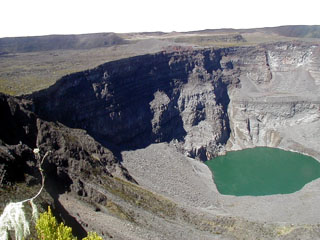Report on Karthala (Comoros) — 24 May-30 May 2006
Smithsonian Institution / US Geological Survey
Weekly Volcanic Activity Report, 24 May-30 May 2006
Managing Editor: Sally Sennert.
Please cite this report as:
Global Volcanism Program, 2006. Report on Karthala (Comoros) (Sennert, S, ed.). Weekly Volcanic Activity Report, 24 May-30 May 2006. Smithsonian Institution and US Geological Survey.
Karthala
Comoros
11.75°S, 43.38°E; summit elev. 2361 m
All times are local (unless otherwise noted)
According to the Toulouse VAAC, the Meteorology Office and Observatory of Comores reported an eruption of Karthala of gas and steam on 28 May at about 2105. During 28-29 May from 2300 to 0930, a thin sulfur-dioxide plume extending 60 km NW was visible on satellite imagery. On 29 May, at about 0830, volcanologists flew above the crater and confirmed that only steam and sulfur dioxide had been emitted. According to a news article, a lava lake fed by a central fountain was also observed.
Geological Summary. The southernmost and largest of the two shield volcanoes forming Grand Comore Island (also known as Ngazidja Island), Karthala contains a 3 x 4 km summit caldera generated by repeated collapse. Elongated rift zones extend to the NNW and SE from the summit of the Hawaiian-style basaltic shield, which has an asymmetrical profile that is steeper to the S. The lower SE rift zone forms the Massif du Badjini, a peninsula at the SE tip of the island. Historical eruptions have modified the morphology of the compound, irregular summit caldera. More than twenty eruptions have been recorded since the 19th century from the summit caldera and vents on the N and S flanks. Many lava flows have reached the sea on both sides of the island. An 1860 lava flow from the summit caldera traveled ~13 km to the NW, reaching the W coast to the N of the capital city of Moroni.
Sources: Reuters, Toulouse Volcanic Ash Advisory Centre (VAAC)

